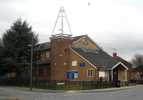 Broxtowe Broxtowe
St Martha
History
The church of St Martha the Housewife was completed in 1956. The planning for the church dated back to the Second World War and the dedication commemorates the service of women during the conflict.
However, long before this church was built there was a medieval chapel at the medieval settlement of Broxtowe, located 2 km east of St Martha's. No traces of this building remained in 1677 when Thoroton wrote his History of Nottinghamshire, although the building still existed in 1595.
During the Second World War plans were drawn up for a new church in Broxtowe. The foundation stone was laid on 14 February 1952 by Miss Marjorie Russell in the presence of the archdeacon of Nottingham, the rural dean and the visiting clergy and congregation of Bilborough Church.
Later that year, on 13 July, the church was dedicated to St Martha by the Bishop of Southwell. The dedication was preceded by a procession of 500 people from Bilborough Church in the presence of the Lord Mayor and Mayoress of Nottingham, the town clerk, the councillors of the Broxtowe and Wollaton wards, the heads of the schools in the parish, and the architect and builders.
The first service was held on 29 July, when an address was given by Monica Hardcastle, principal of St Christopher’s College, London. On 31 January 1963 the church commissioners presented before Her Majesty in Council a proposal for the constituting of a new parish to be taken out of the parishes of Bilborough, and Christ Church, Cinderhill, in Southwell Diocese. On 20 February 1963 at the court of St James, Queen Elizabeth II effected the proposal into law, and two days later the order was published in the London Gazette.
On 26 October 1965 the Guardian Journal reported that an extension was being planned. The proposed additions to the building included a chancel with a north transept, a curved east wall, a hall over the nave, a west portico with a tower, a north porch, central heating, toilets, and a second stairway. The parish had at that stage raised £1,000 for the fund to carry out these works, and hoped to raise a further £1,000 over the course of the following year. The extension works commenced on 28 November 1966 at a contract price of £14,419. 12s. 9d.
The reason for the extension was cited in a letter from the Rev W G E Porter, priest in charge of Broxtowe, dated 4 March 1963. Porter reported that the surrounding housing estate had been occupied for 20 years, and that the church in its present state had taken 10 years to construct:
'I submit it is imperative that this project be finished at the earliest possible date in order to revitalise the hearts and minds… of the faithful before it is too late. It cannot be stated too strongly that the next building of S Martha’s must be a great effort by all concerned to complete the entire project.'
On 30 July 1965, it was reported that the church had purchased a ‘bargain’ second-hand electronic organ for £400. The organ was consecrated by the Assistant Bishop of Southwell, Mark Way, who told a reportedly packed church at the concurrent patronal festival celebrations that ‘St Martha was a real human, down-to-earth person – not a stained glass window one’.
Before the service, the band of St John’s Church Lads’ Brigade (Bilborough) had led a procession through the streets of the parish. Walking behind them were Guides and Brownies of St Martha’s, followed by St John’s choirboys, clergy and congregation.
One bell, formerly at St Christopher’s, Sneinton (by Taylor, 1910), is now fixed to the wall above the rear entrance.
In 1997 St Martha’s became the first turbine-powered church in Britain. Unfortunately the turbine on the tower never worked properly.
| 


